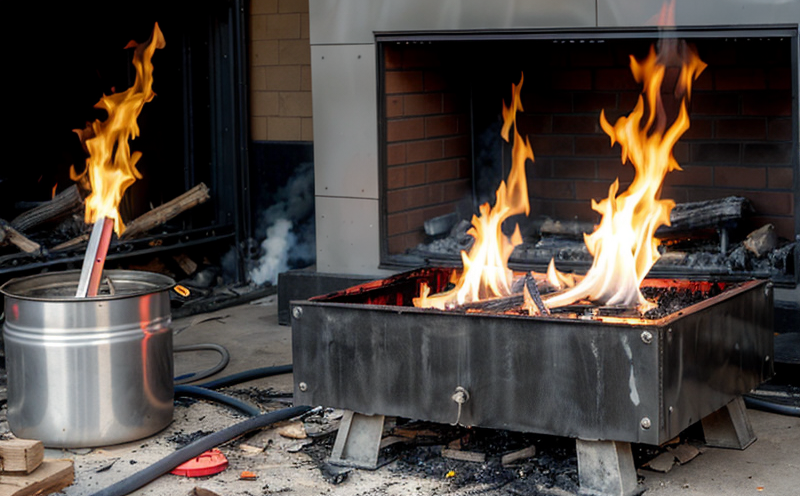ASTM E84 Surface Burning Characteristics of Building Materials
The ASTM E84 standard provides a method to measure the flame spread and smoke development characteristics of building materials. This test is crucial for evaluating the fire performance of construction products, ensuring they meet safety standards and can be used in residential, commercial, or industrial buildings.
ASTM E84 is often referred to as the "Tunnel Test" because it involves a specially designed tunnel that simulates the environment where building materials are exposed to flames. The test measures how quickly fire spreads across the material's surface and quantifies smoke production. This information helps architects, engineers, and builders select materials that can contribute to safer structures.
The ASTM E84 standard is widely recognized in North America and plays a vital role in ensuring compliance with local building codes such as NFPA 251 (Standard Methods of Fire Tests for Building Construction and Materials) and ICC International Residential Code (IRC).
During the test, specimens are placed in the tunnel, which is then subjected to a standard fire source. The time it takes for flames to spread from one end of the specimen to the other is measured as well as the amount of smoke produced during this period. These measurements help determine the flame spread index (FSI) and smoke development index (SDI), which are used to classify materials into Classes A, B1, or B2.
Materials classified in Class A have a low flame spread and minimal smoke production, making them highly desirable for use in fire-resistant applications. Materials that fall into Class B1 represent an intermediate risk with slightly higher flame spread and smoke development compared to Class A materials. Conversely, Class B2 materials show higher levels of flame spread and smoke generation.
The ASTM E84 test is not only essential for manufacturers producing building materials but also critical for architects and engineers designing buildings. By ensuring that the materials used meet the requirements set forth by this standard, they can contribute to safer structures that comply with local regulations and improve overall fire safety.
Why It Matters
The ASTM E84 surface burning characteristics test is crucial for several reasons. Firstly, it ensures that the materials used in construction are safe and do not pose a significant risk of spreading flames or generating excessive smoke during a fire. This aspect is particularly important in densely populated areas such as residential buildings, schools, hospitals, and offices.
Secondly, compliance with ASTM E84 helps avoid potential legal issues and liability risks associated with non-compliant materials. Many jurisdictions have strict building codes that require adherence to standards like ASTM E84, and failing to meet these requirements can lead to fines or even legal action.
Furthermore, the test results contribute to improving fire safety in buildings, which is a critical concern for public health and welfare. By selecting materials with lower flame spread indices (FSI) and smoke development indices (SDI), architects and engineers can design safer buildings that are better equipped to handle emergencies.
Lastly, the ASTM E84 test also supports innovation in the building materials industry by providing clear criteria for material performance. This allows manufacturers to develop new products that meet or exceed the standards set forth by this standard while ensuring they remain competitive in the market.
Industry Applications
| Application | Description |
|---|---|
| Residential Construction | The ASTM E84 test is used to ensure that materials such as insulation, wallboard, and flooring meet fire safety standards. This helps prevent the rapid spread of fire within residential structures. |
| Commercial Buildings | In commercial settings, ASTM E84 ensures that materials like ceilings, partitions, and door assemblies are safe for use in large spaces where fires can quickly spread. This is particularly important for offices, retail stores, and other public areas. |
| Industrial Facilities | For industrial environments, the ASTM E84 test ensures that materials used in corridors, stairwells, and other high-traffic areas are fire-resistant. This helps prevent fires from spreading rapidly through these critical pathways. |
| Hospitals | In healthcare facilities, the ASTM E84 test is essential for ensuring that materials used in operating rooms, patient care areas, and corridors are fire-safe. This reduces the risk of fires starting or spreading within these sensitive environments. |
Quality and Reliability Assurance
The ASTM E84 surface burning characteristics test plays a vital role in quality assurance and reliability by providing objective data on material performance. This ensures that the materials used in construction meet the required standards, thereby enhancing safety and reducing risks associated with fires.
By conducting this test, manufacturers can verify that their products perform as expected under fire conditions. This helps identify any potential issues early in the development process, allowing for necessary adjustments to be made before production begins. In addition, it allows quality assurance teams to monitor performance over time and ensure consistency across batches of materials.
For architects and engineers involved in designing buildings, having reliable data from ASTM E84 tests is crucial when selecting appropriate materials for specific applications. This ensures that the chosen materials will perform consistently with expectations throughout their lifecycle. Furthermore, it helps establish confidence among stakeholders regarding the safety and effectiveness of the building's fire protection measures.
The standardized nature of the ASTM E84 test also promotes consistency across different regions and jurisdictions. With many countries adopting similar standards for fire safety, this ensures that materials tested in one location will perform consistently elsewhere, facilitating international trade and collaboration between industries worldwide.





